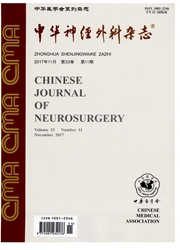

 中文摘要:
中文摘要:
目的 利用三维计算机血流动力学数值模拟技术,数字化地显示动脉瘤及其载瘤动脉的血流速度、轨迹、剪切力等多项参数,结合显微动脉瘤夹闭术中对动脉瘤壁的观察,对动脉瘤破口位置的观察进行对比分析,探讨动脉瘤破口的血流动力学特征和动脉瘤破裂的机制.方法 选取资料完整的动脉瘤患者14例,在三维CTA图像基础上,利用本课题组自写程序及美国Ansys公司的ICEM,美国Fluent公司的Fluent 6.02等,对动脉瘤进行三维计算机血流动力学数值模拟,得出动脉瘤剪切力分布特点,结合动脉瘤夹闭术中所见进行对比分析.结果 根据分析结果我们将患者分为两组.A组:破裂口位于动脉瘤侧壁(10例),模拟结果显示动脉瘤中有涡流产生,破裂口处剪切力在8.5959~10.8419 pascal之间,平均剪切力为9.0704 pascal.B组:破裂口位于动脉瘤底部(4例),模拟结果显示动脉瘤内均无典型涡流,破口处剪切力在0.6983~0.9744 pascal,平均剪切力为0.8364pascal.从A、B两组动脉瘤特点可知,破裂口位于侧壁的动脉瘤内有涡流存在,破口处剪切力较大;破裂口位于底部的动脉瘤内无典型涡流,破裂口处剪切力较小.结论 强剪切力和弱剪切力均与动脉瘤的破裂有关,有助于解释动脉瘤破裂的机制.
 英文摘要:
英文摘要:
Objective With the cranial aneurysm's 3D - computational hemodynamics numerical simulation, we can get the cranial aneurysms and its's mother arteries' blood flow rate, path and wall shearing stress and so on. Taking use of the contrast analysis of the hemodynamics result and the findings in operation,we can try to find the hemodynamic character and the mechanism of the rupture on the aneurysm.Method We choose 14 aneurysm patients with complete clinical data. With the 3D - CTA image, we take use of self - program, American Ansys - ICEM and Fluent6. 02 softwares to simulate blood flow in the aneurysm. Finally we got the wall shearing stress distribution on the aneurysm, and contrastedly analyzed the results and the findings in operation. Result According to the analysis result, we can divide the patients into two groups. Group A:the rapture locates on the side wall of the aneurysm( 10 cases). The simulation results show there is turbulent flow in this kind of aneurysm. The wall shearing stress of the rupture is between 8. 5959 ~ 10. 8419 pascal,and the average is 9. 0704 pascal. Group B:The rupture locates on the tip of the aneurysm (4 cases ). The simulation results show there is no turbulent flow in this kind of aneurysm. The wall shearing stress of the rupture is between 0. 6983 ~ 0. 9744 pascal, and the average is 0. 8364 pascal. According to the character of group A and B,there is turbulent flow in the aneurysm with the rupture on the side wall ,and the wall shearing stress of the rupture is larger. There is no turbulent flow in the aneurysm with the rupture on the tip,and the wall shearing stress of the rupture is smaller. Conclusions If the wall shearing stress is too high or too low,it will cause the rupture of the aneurysm. The deduction helps to explain the mechanism of the aneurysm's rupture.
 同期刊论文项目
同期刊论文项目
 同项目期刊论文
同项目期刊论文
 The effect of aneurismal-wall mechanical properties on patient-specific hemodynamic simulations: two
The effect of aneurismal-wall mechanical properties on patient-specific hemodynamic simulations: two 期刊信息
期刊信息
